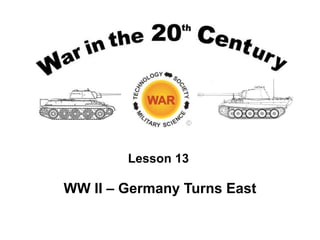
L15-Barbarossa.ppt
- 1. Lesson 13 WW II – Germany Turns East
- 2. Lesson Objectives • Describe and analyze the German decision process to attack the Soviet Union in June 1941. • Describe and analyze the operational and logistic implications of Operation Barbarossa. • Understand and be able to discuss the impact of total war within the Soviet Union. • Understand how the initial successes of the German invasion of the USSR turned into such a total disaster. • Be able to describe the magnitude of the Soviet-German War and its impact on the outcome of World War II.
- 3. Battle of Britain Operation Sealion September 17, 1940 Operation Sealion postponed indefinitely Unable to gain air superiority Approach of winter Review
- 4. Hitler Turns East Germany, USSR signed nonaggression pact (August 23, 1939) After German defeat of Poland, Germany and USSR divided Poland USSR invaded Finland November 30, 1939 (“The Winter War”) • 250,000 Finnish troops vs. 1,000,000 Soviets • By March 1940: 26,000 Finnish dead vs. 126,000 Soviets • Soviet military weakness from 1930’s purges noted by Hitler Background • British, French considered support via Norway and Sweden In July 1940 Hitler told his generals to prepare for war with USSR within a year
- 5. Hitler Turns East Hitler regarded the Soviet Union and Bolshevism as the greatest threat to Germany He felt that the weakness of the Red Army created the best possible opportunity to eliminate this threat • Rejected (or ignored) the possibility of two-front war
- 6. Operation Barbarossa German Invasion of the Soviet Union The classic example of the cost of not learning the lessons of history
- 7. The Impact of Logistics on War Go To
- 8. Why Do We Study War? History doesn’t repeat itself, but it rhymes. Attributed to Samuel Clements (1835-1910)
- 9. Operation Barbarossa June 22, 1941
- 10. Operation Barbarossa Note conquered nation participation
- 14. Operation Barbarossa Siege of Leningrad September 1941 - January 1944 872 days Soviet Dead: Red Army: 330,000+ Civilian: 1,000,000+
- 15. Siege of Leningrad Battle of Moscow October 1941 - January 1942 Germans: 1,000,000 men, 1,700 tanks Soviets: 1,250,000 men, 1,000 tanks
- 16. Battle of Moscow Battle of Stalingrad August 1942 - February 1943
- 17. Battle of Stalingrad August 1942 - February 1943
- 18. Battle of Stalingrad Video (8:24) German Grand Strategy-Russia, N Africa & Oil-12.05
- 19. Battle of Stalingrad August 1942 - February 1943 Fatal Distraction?
- 20. German Grand Strategy German Grand Strategy
- 21. Battle of Kursk July - August 1943
- 23. German-Soviet War Until June 1944 • Soviet Union bore main thrust of German army • Stalin pressed for Second Front
- 24. Soviet Losses
- 25. Soviet Losses The Soviet war effort was so overwhelming that impartial historians of the future are unlikely to rate the British and American contribution to the European theatre as much more than a sound supporting role. Norman Davies Europe at War, 1939-1945 Quoted by Benjamin Schwarz “Stalin's Gift” The Atlantic, May 2007 Significance
- 26. Lesson 14 WW II -- Unrestricted Submarine Warfare and the Second Battle of the Atlantic
- 27. Lesson Objectives • Understand the magnitude and significance of the Battle of the Atlantic during World War II. • Understand the degree of British dependence on maritime lines of communication. • Describe U.S. participation in the Battle of the Atlantic prior to December 1941. • Describe and analyze the tactics and technology used by both sides in the Battle of the Atlantic. • Understand the importance of code breaking in the Atlantic war.
- 28. End